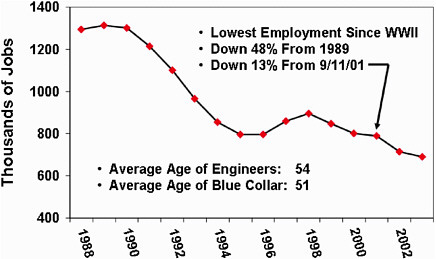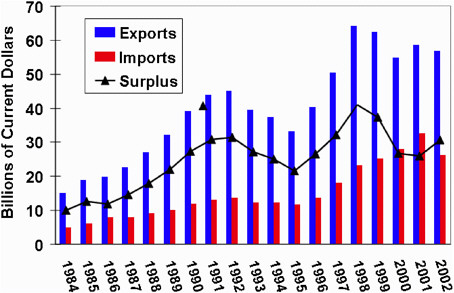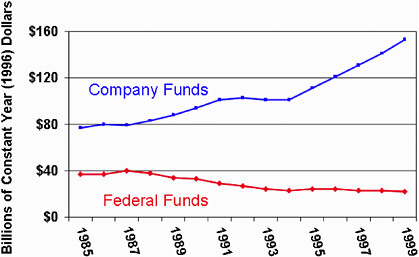9
Drivers and Challenges for U.S. Aerospace Manufacturing
John Tracy
The Boeing Company
Manufacturing at the Boeing Company is driven by sales to the United States aerospace industry, and one of the major manufacturing challenges faced by Boeing is the highly cyclical nature of sales in this industry. The past 2 years have witnessed a downward swing in the cycle, with aerospace sales dropping by about $15 billion. This translates into a wide variation in the number of products delivered by Boeing each year. For example, 526 commercial transport planes, Boeing’s most common product, were delivered 2 years ago compared with 380 last year. Sales projections for this year estimate a further decline, to 270 deliveries.
Sales of Boeing’s high-value products, such as satellites, are no more predictable. During the late 1990s, the global industry delivered approximately 30 to 40 satellites each year. It was predicted that Boeing would deliver 70 satellites in 2002, but there were only two sales that year. Because of the cyclical nature of the aerospace industry, the fallibility of predictions regarding the sale of high-value products such as satellites, and the varying number of products manufactured by Boeing each year, Boeing must develop systems that can handle wide fluctuations. Upfront planning of manufacturing processes, tools, and capital equipment is a major challenge for the aerospace industry. The satellite industry is currently operating at only 12 percent capacity. Currently, the aerospace industry is undergoing a period of contraction, with Boeing itself representing a consolidation of at least three major aerospace companies that existed 10 years ago.
MANUFACTURING AND AEROSPACE INDUSTRY EMPLOYMENT
Manufacturing is a major driver for employment in the aerospace industry, with productivity increases having a dramatic effect on the number of jobs that exist. Employment in the aerospace manufacturing industry is currently the lowest since World War II (Figure 9-1). Discounting the surge in employment during World War II, it is the lowest since the 1930s. Employment is down 48 percent from 1989 and down 13 percent from September 11, 2001. This indicates that the employment trend is influenced not only by productivity increases but also by the economic downturn that resulted from the events of 9/11.
The high average age of workers within the aerospace industry presents additional challenges. Currently, the average age of the engineers who support manufacturing work is 54 years, and the average of the blue-collar team that actually put the product together is 51 years. The imminent retirement of many of these engineers and blue collar workers, combined with the inability to hire new workers in the current economic climate, presents a tremendous challenge of transferring knowledge and skills.

FIGURE 9-1 Aerospace manufacturing industry employment in the United States, 1988 to 2002. SOURCE: Bureau of Labor Statistics and Aerospace Industries Association.
U.S. AND GLOBAL AEROSPACE INDUSTRIES
In 1985, the U.S. aerospace industry constituted 72 percent of the global aerospace market. However, by 1999, this had decreased to 52 percent. Although the United States has dominated the global aerospace industry in the past, the rest of the world is catching up as they realize that aerospace industry jobs are key to their own economies. Jobs in the aerospace industry are desirable because they are high paying and high technology. The civil aviation industry and the products that enable it form 9 percent of the gross domestic product. This creates jobs not only domestically, but throughout the world. For example, during the development of the Boeing 777, approximately 700,000 people worldwide were involved in some way, for example, through supply chain networks. The manufacture of commercial transports therefore has an enormous impact on the global economy.
Boeing is the largest exporter within the United States, and the U.S. aerospace industry is the single largest contributor to the nation’s positive surplus of trade. However, between 1998 and 2000 there was a drop in the surplus of trade by almost 50 percent as a result of foreign competition (Figure 9-2). The product that drives the single largest portion of the trade surplus is commercial transport planes. The largest driver for commercial transport sales is airline passenger traffic. During the past 30 years, passenger growth has been constant and the demand for commercial transports has grown. However, over the past few years, there has been a significant decline in passenger traffic in the United States. Several U.S. airlines have declared bankruptcy as a result. In Europe and the rest of the world, however, passenger growth has regained the place that it held prior to September 11, 2001, and global airlines are therefore not suffering to the same extent as U.S. airlines.
In the long term, there is a huge market for the aerospace industry. Currently, about

FIGURE 9-2 Total imports and exports of the U.S. aerospace industry, 1984 to 2002. SOURCE: Aerospace Industries Association, based on data from the Department of Commerce.
10,000 commercial transports operate worldwide. Due to aging of that fleet, it is estimated that a total of 4,500 replacements will be required by 2009 and a total of 9,000 replacements will be required by 2019. This estimate assumes no growth in passenger and freight travel. With an estimated modest growth rate of 3.7 percent per year in passenger and freight travel, an additional 4,500 planes would be required by 2009. Over the next 20 years, this market for commercial transports alone is predicted to be worth about $1.8 trillion.
MANUFACTURING PROCESSES AT BOEING
To keep pace with the competition, Boeing faces several manufacturing process challenges. The order and delivery cycles for transport aircraft since 1958 are fairly regular, between 10 and 12 years long, but are always out of phase. During periods when the airline industry reaps profits, orders for new transport aircraft are placed. However, due to the length of time required for manufacturing, by the time the planes are ready, the airline companies are often facing a low market and therefore withdraw their orders. The ability of Boeing to shorten the manufacturing and design build time is a critical challenge. Manufacturing optimization goals at Boeing include a reduction in cycle time by 60 percent and a reduction in build hours by 50 percent.
PRIORITY MANUFACTURING TECHNOLOGIES
The aerospace industry is a very mature industry, and Boeing has been building airplanes for almost 100 years. Technology solutions within this industry are therefore
evolutionary rather than revolutionary when compared with other fields such as biotechnology, where technology is exploding. However, some areas of manufacturing technology that are a high priority for improvement include:
-
Single source of production data;
-
Integrated design/build/quality and supplier processes;
-
Simplified manufacturing planning; and
-
Design for manufacturing.
Boeing has already made progress in a number of these areas, including the integration of design and manufacturing. Several computer-based models are currently available that are used by engineers to design products. Duplication is avoided and efficiency significantly increased when the same computer-based model is used on the factory floor (to show the technicians how to put the product together) and by the inspectors (to show them how to inspect the product). In addition, progress has been made in validating systems through electronic simulation. Previously, prototypes and “iron birds” were built that looked just like the airplane but that couldn’t fly. These were used to ensure that plumbing was routed correctly. Today, virtual manufacturing is used to virtually demonstrate the prototype instead. This results in both time and cost savings.
One of the biggest manufacturing challenges encountered by Boeing is the drilling and filling of holes. Two years ago, Boeing was drilling, at great expense, approximately 1.2 million holes per day, or over 365 million holes per year. In the past, expensive machine tools were used that were often bigger than the airplanes. New developments in lasers and computers have enabled these machines to be replaced by smaller machines that achieve the same productivity and can be operated by a single individual. In addition, Boeing has reduced the number of holes and fasteners in its products by the use of new welding processes (friction stir joining), new design approaches, and new, simple manufacturing technologies. As a result, the quality of the product has been increased by a factor of 20.
Lean manufacturing approaches, based on the Toyota production system from the early 1990s, are now being used by the aerospace industry to eliminate waste, eliminate unnecessary inventory, and to eliminate “monuments,” i.e., large and bulky items that cannot be moved around and that thereby limit the flexibility to make changes in the rate of production. Boeing is currently spending a lot of time on lean activities. One example is in the production of composites. Certain pieces of large and capital-intensive equipment, such as autoclaves and nondestructive testing equipment, have been completely eliminated by the use of new materials approaches.
On planes such as the 737 and 747, the aerospace industry has shifted to the use of moving production lines in order to shorten assembly cycle times. This requires modification of all of the systems that support the manufacturing activity, which in turn has resulted in a rethinking of the entire production system. For example, computer modeling and laser trackers have replaced large fixtures and tools for assembly.
New materials technologies, such as fiber-metal laminates, new aluminum alloys, metal-matrix composites, and new composite processing, are appearing every day. A major challenge for Boeing is to make sure that product manufacturing processes are adaptable enough to handle these new materials technologies. The challenge is to integrate these new technologies with existing manufacturing processes. In the past, this process took approximately 10 years because of the time it took to create a knowledge base for designing parts with these new

FIGURE 9-3 Funding for manufacturing industry research and development in the United States, 1985 to 1999.
materials and learning how to build with them. Currently, there are several programs at Boeing focused on reducing this lag time.
Changing the part count and the design process can have a huge impact on manufacturing and manufacturing costs. There is currently a debate at Boeing over new ways of thinking about common parts. For example, a strut is a part that holds the engine onto a commercial transport. It consists of hundreds of pieces. New ways of using casting technology can reduce this number of pieces by 90 percent and can reduce the number of fasteners needed by 80 percent. This will improve the durability of the product.
CONCLUSION
Boeing’s near-term manufacturing priorities are reducing and standardizing holes and fasteners; improving composite processing; shortening assembly and cycle times; improving support services by technology applications; monolithic structures; turning suppliers into partners; and integrating design and manufacturing. In addition to these near-term priorities, Boeing has identified a number of long-term goals, including simplifying joining techniques; introducing advanced composites by eliminating autoclaves and inspections; lean integrated service support; making production processes ready to adapt to new materials; reducing the part count; and integrating the production system. During the past 15 years, the U.S. manufacturing industry has nearly doubled its spending on manufacturing research and development, while federal funding has decreased (Figure 9-3). Industry funds, however, are focused on very near term needs. Federal funding is needed to focus on the high-risk activities that may have a large impact on the industry in the long term.






